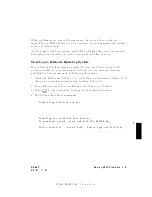
FINAL
TRIM
SIZE
:
7.0
in
x
8.5
in
7
text
of
the
panic
message,
just
in
case
y
ou
need
it
for
future
troublesho
oting
or
help
from
HP
service
p ersonnel.
Step
4:
Rebooting
Y
our
System
Once
y
ou
ha
v
e
c
hec
k
ed
for
and
corrected
an
y
problems
from
Step
3,
y
ou
are
ready
to
reb o ot
y
our
system.
Y
ou
can
reb o ot
y
our
system
using
the
TOC
button
on
the
bac
k
of
the
w
orkstation.
Otherwise,
y
ou
can
turn
y
our
w
orkstation
o
and
then
bac
k
on
to
initiate
the
b o ot
sequence.
Y
ou
will
probably
notice
a
few
dierences
in
b o ot
b eha
vior
as
compared
with
y
our
normal
b o ot
sequence.
Y
our
w
orkstation
might
sa
v
e
a
\core"
le
to
disk.
This
core
le
is
a
\snapshot"
of
the
previously
running
k
ernel
at
the
time
that
it
panic
k
ed.
If
it
b ecomes
necessary
,
this
core
le
can
b e
analyzed
using
sp ecial
to
ols
to
determine
more
ab out
what
caused
the
panic.
Note
Core
les
are
quite
large
and
are
sa
v
ed
to
the
directory
/tmp/syscore .
If
y
ou
feel
y
ou
need
to
sa
v
e
these
les
for
future
analysis
(something
that
isn't
usually
required),
it
is
b est
to
sa
v
e
them
to
tap
e
and
remov
e
them
from
y
our
le
system
in
order
to
free
up
space.
If
y
ou
know
wh
y
y
our
system
panic
k
ed,
y
ou
can
delete
the
core
les;
it
is
unnecessary
to
k
eep
them.
The
core
les
are
used
in
rare
circumstances
to
diagnose
hard-to-nd
causes
of
system
panics.
If
the
reason
y
our
system
panic
k
ed
w
as
b ecause
of
a
corrupted
le
system,
fsck
will
rep ort
the
errors
and
an
y
corrections
it
makes.
If
the
problems
w
ere
asso
ciated
with
y
our
ro
ot
le
system,
fsck
will
ask
y
ou
to
reb o ot
y
our
system
when
it's
nished.
When
y
ou
do
this,
use
the
command:
reboot
-n
The
-n
option
tells
reb o ot
not
to
sync
the
le
system
b efore
reb o oting.
Since
fsck
has
made
all
the
corrections
on
disk,
y
ou
do
not
w
an
t
to
undo
the
c
hanges
b
y
writing
o
v
er
them
with
the
corrupt
memory
buers.
7-18
Dealing
With
Problems
DRAFT
2/5/97
11:31






























